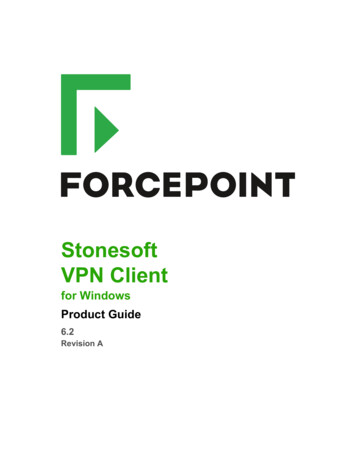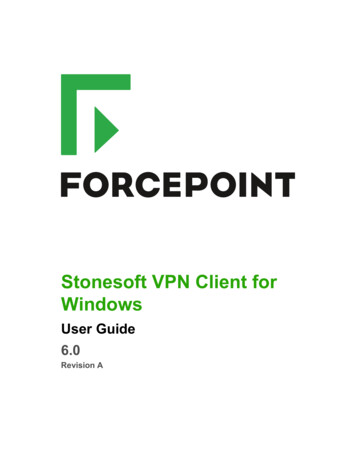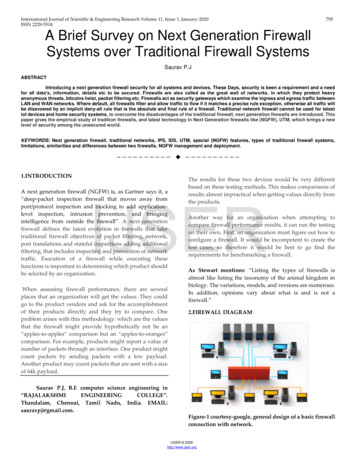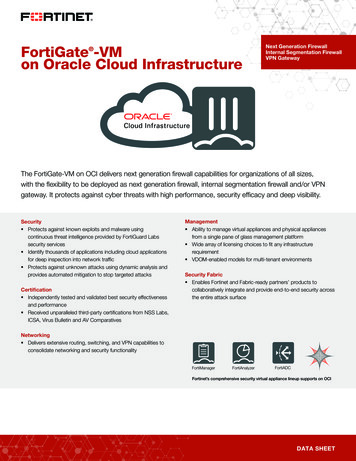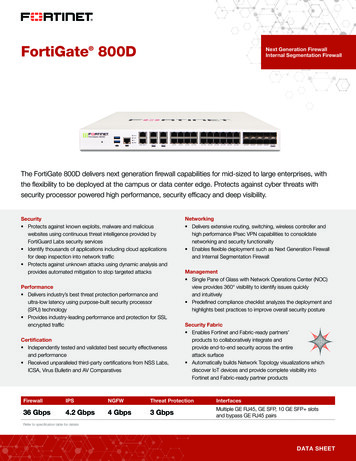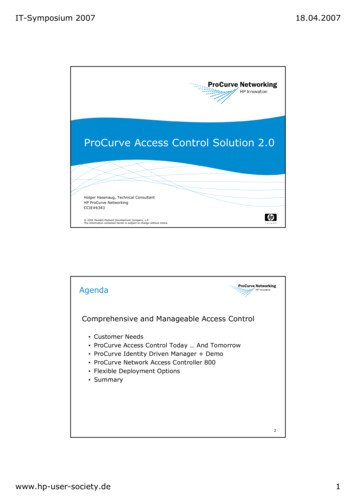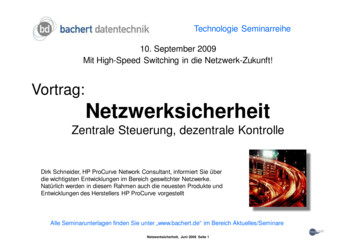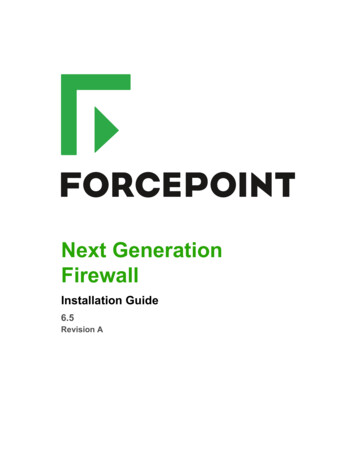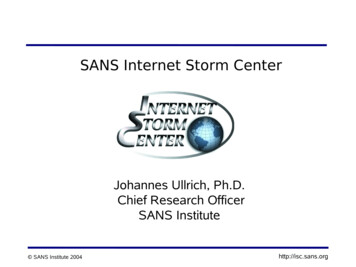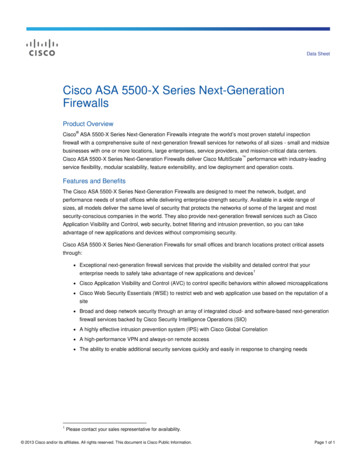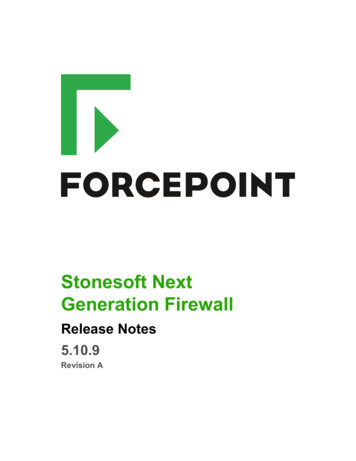
Transcription
Stonesoft NextGeneration FirewallRelease Notes5.10.9Revision A
Table of contents1 About this release.3Lifecycle model.3System requirements. 3Build version.6Compatibility. 72 New features.83 Enhancements. 94 Resolved issues. 105 Installation instructions.12Upgrade instructions. 126 Known issues. 13Known limitations. 137 Find product documentation. 14Product documentation. 142
About this releaseThis document contains important information about this release of Stonesoft Next Generation Firewall byForcepoint (Stonesoft NGFW; formerly known as McAfee Next Generation Firewall). We strongly recommendthat you read the entire document.NGFW version 5.10.1 has been evaluated against the Common Criteria Network Devices Protection Profile withExtended Package Stateful Traffic Filter Firewall. For more details, see id 10669.Note: We have started rebranding the NGFW product and the NGFW product documentation. Weuse Stonesoft as the product name in this document. However, the old product name is still usedin the NGFW appliances and the product documentation set that we created for the NGFW 5.10.0release.Lifecycle modelThis release of Stonesoft Next Generation Firewall is a Long-Term Support (LTS) version.We recommend using the most recent Long-Term Support (LTS) version if you do not need any features from alater Feature Stream version.For more information about the Stonesoft Next Generation Firewall lifecycle policy, see Knowledge Base article10192.System requirementsMake sure that you meet these basic hardware and software requirements.Stonesoft NGFW appliancesWe strongly recommend using a pre-installed Stonesoft NGFW appliance as the hardware solution for newStonesoft NGFW installations.Note: Some features in this release are not available for all appliance models. See KnowledgeBase article 9743 for up-to-date appliance-specific software compatibility information.Two Stonesoft NGFW engine images are available: x86-64 — A 64-bit image that includes the Local Manager.x86-64-small — A 64-bit image that does not include the Local Manager.Note: If you do not use the Local Manager, we recommend that you use the x86-64-small image.Some appliance models support only the x86-64-small image.The following table shows whether you can use an appliance model in the Firewall/VPN (FW), IPS, or Layer 2Firewall (L2FW) role, and the image that is supported.About this release 3
Appliance modelRolesImagesFW-315FWThe image that does not include the Local Manager is supported320X (MIL-320)FWBoth images are supportedIPS-1205IPS, L2FWBoth images are supportedFWL321FWThe image that does not include the Local Manager is supportedNGF321FW, IPS, L2FWBoth images are supportedFWL325FWThe image that does not include the Local Manager is supportedNGF325FW, IPS, L2FWBoth images are supported110FWThe image that does not include the Local Manager is supported1035FW, IPS, L2FWBoth images are supported1065FW, IPS, L2FWBoth images are supported1301FW, IPS, L2FWBoth images are supported1302FW, IPS, L2FWBoth images are supported1401FW, IPS, L2FWBoth images are supported1402FW, IPS, L2FWBoth images are supported3201FW, IPS, L2FWBoth images are supported3202FW, IPS, L2FWBoth images are supported3205FW, IPS, L2FWBoth images are supported3206FW, IPS, L2FWBoth images are supported3207FW, IPS, L2FWBoth images are supported3301FW, IPS, L2FWBoth images are supported3305FW, IPS, L2FWBoth images are supported5201FW, IPS, L2FWBoth images are supported5205FW, IPS, L2FWBoth images are supported5206FW, IPS, L2FWBoth images are supportedSidewinder S-series appliancesThese Sidewinder appliance models can be re-imaged to run Stonesoft NGFW software.Appliance modelRolesImagesS-1104FWBoth images are supportedS-2008FWBoth images are supportedS-3008FWBoth images are supportedS-4016FWBoth images are supportedS-5032FWBoth images are supportedS-6032FWBoth images are supportedAbout this release 4
Certified Intel platformsWe have certified specific Intel-based platforms for Stonesoft NGFW.The tested platforms can be found at https://support.forcepoint.com under the Stonesoft Next Generation Firewallproduct.We strongly recommend using certified hardware or a pre-installed Stonesoft NGFW appliance as the hardwaresolution for new Stonesoft NGFW installations. If it is not possible to use a certified platform, Stonesoft NGFWcan also run on standard Intel-based hardware that fulfills the hardware requirements.Basic hardware requirementsYou can install Stonesoft NGFW on standard hardware with these basic requirements. (Recommended for new deployments) Intel Xeon -based hardware from the E5-16xx product family orhigherNote: Legacy deployments with Intel Core 2 are supported. IDE hard disk and CD driveNote: IDE RAID controllers are not supported. Memory: 4 GB RAM minimum for x86-64-small installation 8 GB RAM minimum for x86-64 installationVGA-compatible display and keyboardOne or more certified network interfaces for the Firewall/VPN roleTwo or more certified network interfaces for IPS with IDS configurationThree or more certified network interfaces for Inline IPS or Layer 2 FirewallFor information about certified network interfaces, see Knowledge Base article 9721.Master Engine requirementsMaster Engines have specific hardware requirements. Each Master Engine must run on a separate physical device. For more details, see the Stonesoft NextGeneration Firewall Installation Guide.All Virtual Security Engines hosted by a Master Engine or Master Engine cluster must have the same role andthe same Failure Mode (fail-open or fail-close).Master Engines can allocate VLANs or interfaces to Virtual Security Engines. If the Failure Mode of the VirtualIPS engines or Virtual Layer 2 Firewalls is Normal (fail-close) and you want to allocate VLANs to severalengines, you must use the Master Engine cluster in standby mode.Cabling requirements for Master Engine clusters that host Virtual IPS engines or Layer 2 Firewalls: Failure Mode Bypass (fail-open) requires IPS serial cluster cabling.Failure Mode Normal (fail-close) requires Layer 2 Firewall cluster cabling.For more information about cabling, see the Stonesoft Next Generation Firewall Installation Guide.About this release 5
Virtual appliance node requirementsYou can install Stonesoft NGFW on virtual appliances with these hardware requirements. Also be aware of somelimitations. (Recommended for new deployments) Intel Xeon -based hardware from the E5-16xx product family orhigherNote: Legacy deployments with Intel Core 2 are supported. One of the following hypervisors: VMware ESXi 5.5 and 6.0Note: Stonesoft Next Generation Firewall 5.10.9 does not support integration with IntelSecurity Controller and deployment on VMware NSX. KVM (KVM is tested as shipped with Red Hat Enterprise Linux Server 7.0) Oracle VM server 3.3 (tested with Oracle VM server 3.3.1)8 GB virtual disk4 GB RAM minimumA minimum of one virtual network interface for the Firewall/VPN role, three for IPS or Layer 2 Firewall rolesWhen Stonesoft NGFW is run as a virtual appliance node in the Firewall/VPN role, these limitations apply: Only Packet Dispatching CVI mode is supported.Only standby clustering mode is supported.Heartbeat requires a dedicated non-VLAN-tagged interface.When Stonesoft NGFW is run as a virtual appliance node in the IPS or Layer 2 Firewall role, clustering is notsupported.Build versionStonesoft Next Generation Firewall 5.10.9 build version is 14107.Product binary checksumsUse the checksums to make sure that the installation files downloaded correctly. sg engine 5.10.9.14107 9f93f34763371e189381About this release 6
sg engine 5.10.9.14107 7b95fcdd629c8e3c3a2f sg engine 5.10.9.14107 d5e83a2e43792ecd099c125ce9 sg engine 5.10.9.14107 8932368b1601d2298b09f8f2e8CompatibilityStonesoft NGFW 5.10.9 is compatible with the following component versions. McAfee Security Management Center (SMC) 5.10.0 or laterDynamic Update 810 or laterStonesoft IPsec VPN Client 5.3.0 or laterMcAfee VPN Client for Windows 5.9.0 or laterMcAfee VPN Client for Mac OS X 1.0.0 or laterMcAfee VPN Client for Android 1.0.1 or laterServer Pool Monitoring Agent 4.0.0 or laterMcAfee Logon Collector 2.2 and 3.0McAfee Advanced Threat Defense 3.6McAfee Endpoint Intelligence Agent (McAfee EIA) 2.5About this release 7
New featuresThis release of the product includes these new features. For more information and configuration instructions, seethe Stonesoft Next Generation Firewall Product Guide.Note: Stonesoft Next Generation Firewall 5.10.9 does not support integration with Intel SecurityController and deployment on VMware NSX.Support for Threat Intelligence ExchangeStonesoft NGFW can now query file reputations and receive reputation updates from the McAfee ThreatIntelligence Exchange (TIE) server. TIE makes it possible for administrators to tailor comprehensive local threatintelligence from global intelligence data sources, such as McAfee Global Threat Intelligence (McAfee GTI),endpoints, gateways, and other security components. File reputation data is exchanged using the McAfee DataExchange Layer (DXL) broker network. File reputation updates ensure that Stonesoft NGFW engines alwayshave the latest file reputations available for use in file filtering.Single sign-on (SSO) to SSL VPN PortalThe SSL VPN Portal (reverse web proxy) can be configured to cache user credentials. The portal logs on to theback-end servers with the credentials as if they came from the web browser at the endpoint. You can group theservers that use the same credentials by SSO domain, to further reduce the need to re-enter the password.New tunnel type for the route-based VPNA new tunnel type for the route-based VPN allows the use of tunnel mode IPsec without an additional tunnelinglayer. The route-based VPN configuration dialog box has been improved.Connectivity between Stonesoft NGFW and SMC using IPv6Engines that only use IPv6 to connect to the Internet can now be managed by SMC over the Internet using IPv6based management connections. Connectivity between SMC components still requires IPv4 addressing andconnectivity.Network Security for Industrial Control Systems (ICS)ICS support has been enhanced with deep inspection support for DNP3 (TCP/UDP) and Open PlatformCommunications Unified Architecture (OPC UA).Safe search supportStonesoft NGFW can be configured to enforce safe search usage for Google, Bing, Yahoo, and DuckDuckGoweb searches.New features 8
EnhancementsThis release of the product includes these enhancements.Enhancements in Stonesoft NGFW version 5.10EnhancementDescriptionAdvanced Threat Defense Improvements have been made to the communication protocol and loggingcommunication loggingfeatures between McAfee Advanced Threat Defense and Stonesoft NGFW.improvementsStonesoft NGFW now logs the dynamic analysis results when available fromAdvanced Threat Defense. Stonesoft NGFW provides the file name, destination IPaddress, and URL details when sending the file to Advanced Threat Defense foranalysis.File filtering improvements Improvements have been made to file type detection and filtering. We recommendthat you update your file filtering policies with the new file type categories.DHCP servicesIt is now possible to use DHCP server and DHCP relay services on differentinterfaces of the same Stonesoft NGFW engine.Enhancements in Stonesoft NGFW version 5.10.3EnhancementDescriptionDynamic routingenhancementsDynamic routing features, such as graceful restart for OSPF and BGP, have beenimproved. The stability of dynamic routing has also been improved.Enhancements in Stonesoft NGFW version 5.10.4EnhancementDescriptionImproved alerting foroffline transitionsAlerting for offline transitions has been improved. Alerts are now created forunexpected offline transitions, such as heartbeat recovery, or nodes that havedifferent policies.Faster policy installationfor Virtual SecurityEnginesPolicy installation is now faster in environments that have many Virtual SecurityEngines.Enhancements in Stonesoft NGFW version 5.10.8EnhancementDescriptionEngine monitoringenhancementsEngine monitoring has been improved. If the monitoring connection through aprimary Control Interface fails, the backup Control Interface is used.Improved logging for FileFilteringLogging for File Filtering has been improved significantly. For example, all FileFiltering Situations are now logged under File Filtering in the Facility column of theLogs view.Inspection with a largernumber of Virtual SecurityEnginesInspection can now be used with a larger number of Virtual Security Engines thatare hosted on a single Master Engine.Enhancements 9
Resolved issuesThese issues are resolved in this release of the product. For a list of issues fixed in earlier releases, see theRelease Notes for the specific release.DescriptionRoleSYN flood protection might consume too much memory.FW, IPS, L2FW NGFW-275User information provided by McAfee Endpoint Intelligence Agent (EIA)overrides user information from user authentication, such as authenticationusing the Stonesoft VPN Client or Browser-Based User Authentication.FWUsing a license that allows the use of a single CPU with hardware that hasmultiple CPUs causes instability.FW, IPS, L2FW NGFW-743When you downgrade Master Engines to an earlier version of the StonesoftNGFW engine software, the Master Engines might lose connectivity to theManagement Server.FW, IPS, L2FW NGFW-983DHCP relay might stop working when you modify a VLAN Interface that has FWDHCP Relay enabled.Issue numberNGFW-352NGFW-1274TCP connections to the engine itself might be slow when the connectiongoes through an interface that uses the MOD-EM2-10G-SFP-4/MOE10F4or MOD-40G-2/MO40F2 interface modules.FW, IPS, L2FW NGFW-1305QoS cannot be applied to multicast traffic.FWNGFW-1361When you delete VPN SAs manually from a cluster in a load-balancingmode, notifications might not be sent to the VPN peers. The lack ofnotifications might cause small delays in the renegotiation of the VPN SAs.FWNGFW-1420Forwarding VPN Client traffic from an SSL VPN tunnel to a Route-BasedVPN tunnel that has the VPN tunnel type might not work correctly.FWNGFW-1601Refreshing the policy on Master Engines or Virtual Security Engines mightcause latency in VPN traffic.FWNGFW-1616When the SNMP agent must process a large number of ARP cache entries, FW, IPS, L2FW NGFW-1775SNMP queries to retrieve ARP cache entries might time out.ICMP connections might not be cleared from the Connection Monitoringview.FW, IPS, L2FW NGFW-1784When interfaces that support 10Gb or 40 Gb throughput do not have VLANInterfaces or Aggregated Link Interfaces configured, some part of the trafficmight stop flowing through the interfaces over time.FWNGFW-1817On Firewall Clusters, the maximum throughput for some VPN connectionsmight be lower than for other VPN connections that use the same VPNgateways.FWNGFW-2032When you use a Virtual Firewall as a VPN gateway, VPN tunnels that useIKEv1 might experience intermittent issues. During the issue, the followingmessage is shown in the logs: "IPsec SA install failed: Lost concurrentnegotiation arbitration".FWNGFW-2082When a remote gateway in a Multi-Link VPN has endpoints with dynamic IP FWaddresses, policy installation might fail. The following type of error messageis shown: "Engine error: Message code 208 (errno 104)Proposal number referring to an unsupported hash algorithm hash ".NGFW-2084Resolved issues 10
DescriptionRoleIssue numberThe engine might not be able to decrypt HTTPS traffic from Googleapplications on Android devices.FW, IPS, L2FW NGFW-2116On engines that have a large number of Physical Interfaces or VLANInterfaces, Aggregated Link Interfaces might not work correctly.FWThe engine might restart when VoIP connections are processed using theSIP Protocol Agent.FW, IPS, L2FW NGFW-2509NGFW-2340Resolved issues 11
Installation instructionsUse these high-level steps to install SMC and the Stonesoft NGFW engines.For detailed information, see the Stonesoft Next Generation Firewall Installation Guide. All guides are availablefor download at https://support.forcepoint.com.Note: The sgadmin user is reserved for SMC use on Linux, so it must not exist before SMC isinstalled for the first time.1.2.3.4.5.6.Install the Management Server, the Log Servers, and optionally the Web Portal Servers.Import the licenses for all components.You can generate licenses at https://stonesoftlicenses.forcepoint.com.Configure the Firewall, IPS, or Layer 2 Firewall elements with the Management Client using the SecurityEngine Configuration view.To generate initial configurations for the engines, right-click each Firewall, IPS, or Layer 2 Firewall element,then select Configuration Save Initial Configuration.Make a note of the one-time password.Make the initial connection from the engines to the Management Server, then enter the one-time password.Create and upload a policy on the engines using the Management Client.Upgrade instructionsTake the following into consideration before upgrading licenses, engines, and clusters. Upgrading to version 5.10.x is only supported from version 5.8.x or later. If you have an earlier version, firstupgrade to the latest 5.8.x version.Stonesoft NGFW 5.10.x requires an updated license if upgrading from version 5.9.x or earlier. The licenseupgrade can be requested at https://stonesoftlicenses.forcepoint.com. Install the new license using theManagement Client before upgrading the software. If communication between the SMC and the license serveris enabled and the maintenance contract is valid, the license is updated automatically.To upgrade the engine, use the remote upgrade feature or reboot from the installation CD and follow theinstructions. For detailed instructions, see the Stonesoft Next Generation Firewall Installation Guide.Take the following software architecture information into consideration. Stonesoft NGFW appliances support only the software architecture version with which they come installed.32-bit versions (i386) can only be upgraded to another 32-bit version and 64-bit versions (x86-64) can only beupgraded to another 64-bit version.Clusters can only have online nodes that use the same software architecture version.State synchronization between 32-bit and 64-bit versions is not supported.Changing the architecture of third-party servers using software licenses requires the software to be fully reinstalled from CD.Stonesoft NGFW version 5.10 only supports 64-bit software architecture. Except for the FW-315 appliance,the last supported software version for 32-bit Firewall/VPN appliances is 5.8.To upgrade a cluster (consisting of FW-315 appliances or third-party hardware using software licenses) from a32-bit to 64-bit version, see Knowledge Base article 9875.Installation instructions 12
Known issuesFor a list of known issues in this product release, see Knowledge Base article 10138.Known limitationsThis release of the product includes these known limitations.LimitationDescriptionInspection in asymmetricallyrouted networksIn asymmetrically routed networks, using the stream-modifying features (TLSInspection, URL filtering, and file filtering) can make connections stall.SSL/TLS inspection in capture Due to SSL/TLS protocol security features, SSL/TLS decryption in capture(IDS) mode(IDS) mode can only be applied in a server protection scenario when RSA keyexchange negotiation is used between the client and the server.Inline Interface disconnectmode in the IPS roleThe disconnect mode for Inline Interfaces is not supported on IPS virtualappliances, IPS software installations, IPS appliance models other thanIPS-6xxx, or modular appliance models that have bypass interface modules.Known issues 13
Find product documentationOn the Forcepoint support website, you can find information about a released product, including productdocumentation, technical articles, and more.You can get additional information and support for your product on the Forcepoint support website athttps://support.forcepoint.com. There, you can access product documentation, Knowledge Base articles,downloads, cases, and contact information.Product documentationEvery Forcepoint product has a comprehensive set of documentation. Stonesoft Next Generation Firewall Product GuideStonesoft Next Generation Firewall online HelpNote: By default, the online Help is used from the Forcepoint help server. If you want to usethe online Help from a local machine (for example, an intranet server or your own computer),see Knowledge Base article 10097. Stonesoft Next Generation Firewall Installation GuideOther available documents include: Stonesoft Next Generation Firewall Hardware Guide for your modelStonesoft Management Center Appliance Hardware GuideStonesoft Next Generation Firewall Quick Start GuideStonesoft SMC API Reference GuideStonesoft VPN Client User Guide for Windows or MacStonesoft VPN Client Product GuideThe following document included in appliance deliveries still uses the old product name and brand: McAfee Security Management Center Appliance Quick Start GuideCopyright 1996 - 2017 Forcepoint LLCForcepoint is a trademark of Forcepoint LLC.SureView , ThreatSeeker , TRITON , Sidewinder and Stonesoft are registered trademarks of Forcepoint LLC.Raytheon is a registered trademark of Raytheon Company.All other trademarks and registered trademarks are property of their respective owners.Find product documentation 14
McAfee VPN Client for Windows 5.9.0 or later McAfee VPN Client for Mac OS X 1.0.0 or later McAfee VPN Client for Android 1.0.1 or later Server Pool Monitoring Agent 4.0.0 or later McAfee Logon Collector 2.2 and 3.0 McAfee Advanced Threat Defense 3.6 McAfee Endpoint Intelligence Agent (McAfee EIA) 2.5
